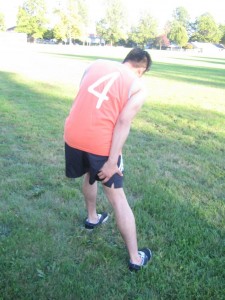A quadriceps or thigh strain involves tearing in one of the quadriceps muscles in the front part. The injury can range from minimal discomfort to a complete muscle tear that results to significant pain and inability to walk.
Possible causes
Damage to the quadriceps muscles typically occur after certain movements such as jumping, sprinting or kicking particularly if proper warm-up is not done. Any of the structures in the quadriceps muscles can end up torn specifically the rectus femoris.

The injuries that develop after direct impact to the muscle such as a ball are likely to cause contusions which are treated in a different manner.
Indications of a thigh strain
- Abrupt sharp pain or discomfort at the anterior part of the thigh
- Swelling and bruising
A thigh strain can be graded 1-3 based on the severity of the damage. A grade 1 injury is mild while a grade 3 involves severe damage due to complete tearing of the muscle.
An individual with a grade 1 thigh strain might be able to resume activity at the time of injury. As for grade 2 or 3 strains, the individual should take a break from activity or sports.
Management
The primary mode of care for a thigh strain is the PRICE method.
- The damaged muscle should be protected with a support for the thigh or compression bandage.
- The individual should take a break from all sports or physical activities during the initial phases of healing. The injured limb should be raised by using cushions while in a lying position.
- Apply an ice pack along with a compression wrap during the initial 72 hours after the injury. The application should be 10 minutes every hour initially to stop any internal bleeding and swelling.
- Compression works by reducing the swelling as well as protecting the affected area.
- Elevate the affected limb to reduce the swelling and promote drainage of fluid from the site of injury.
If a sports injury professional is consulted, an accurate diagnosis can be given and might suggest electrotherapy specifically ultrasound to promote healing. In some cases, sports massage can also help once the initial phase has passed. A rehabilitation program is started which includes strengthening and stretching exercises.
More Information / Disclaimer
The information posted on this page on a thigh strain is for learning purposes only. Learn to recognize and manage strains by taking a standard first aid course with Ottawa First Aid.
